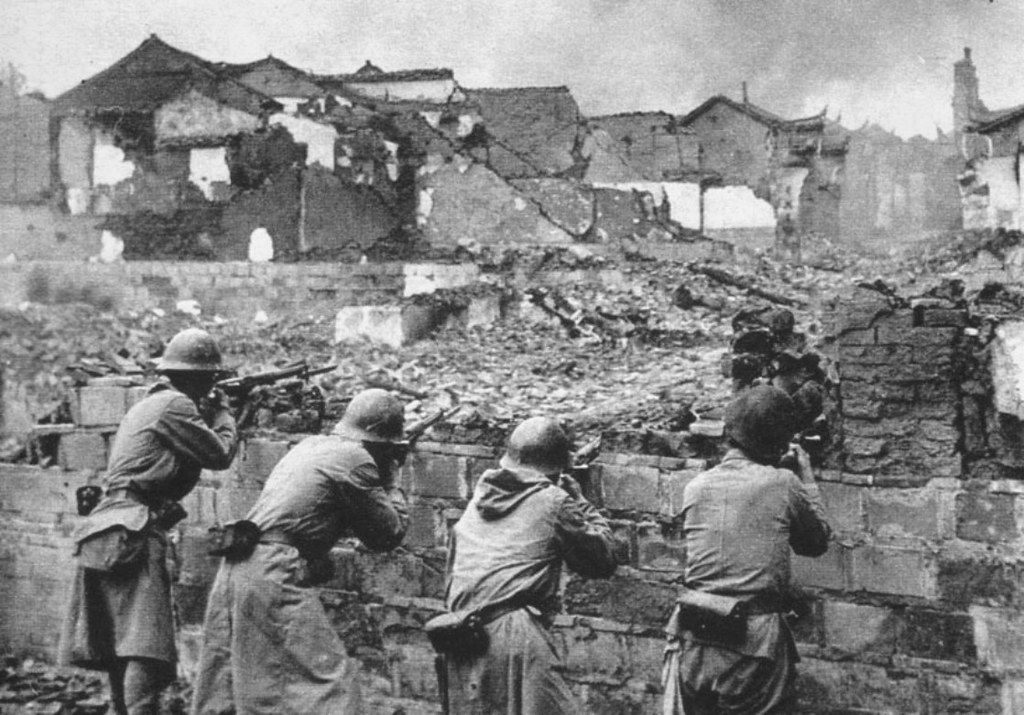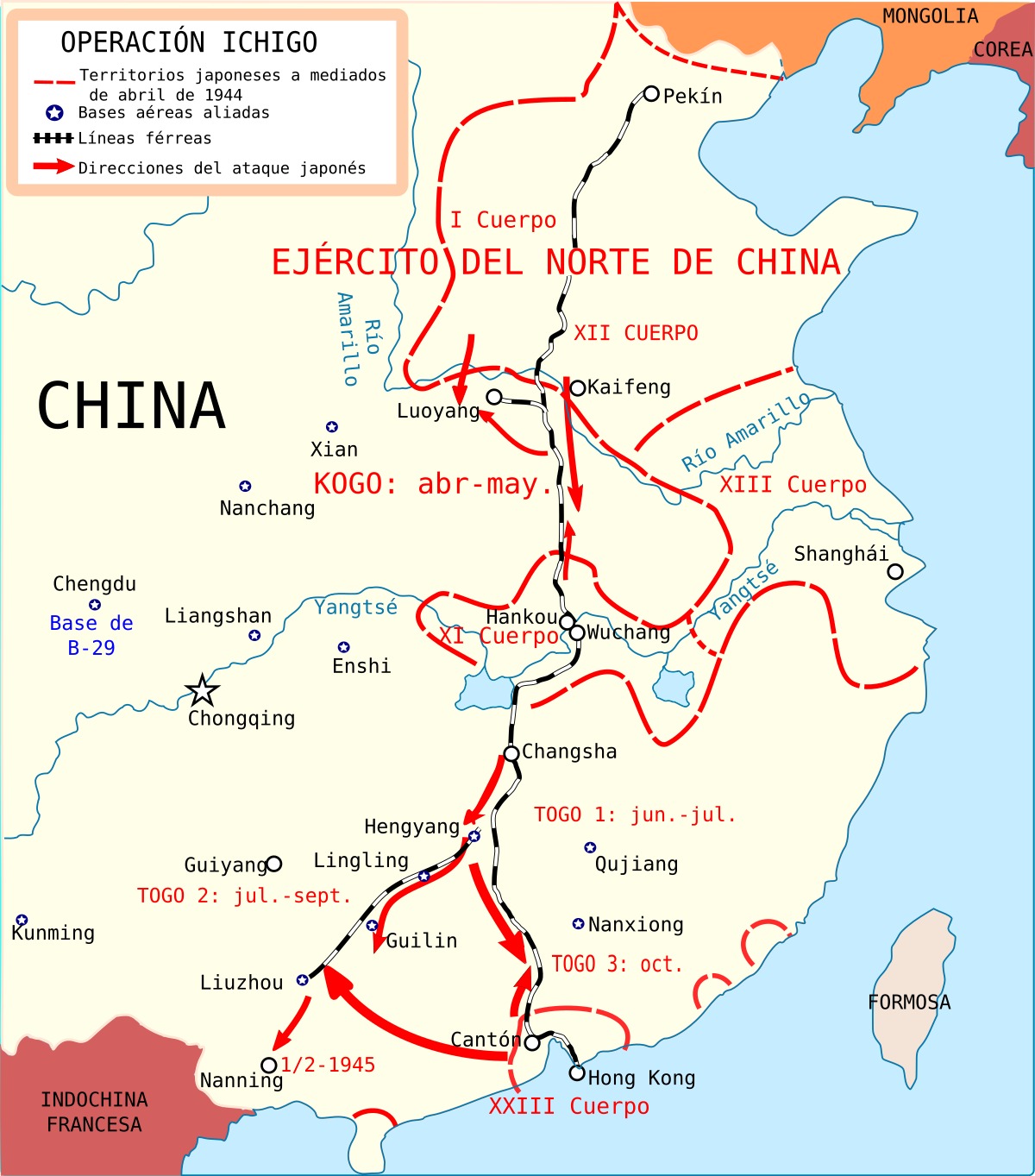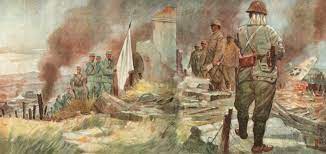
In the annals of military history, certain operations stand out as pivotal moments that shaped the course of a conflict. One such operation is the lesser-known but strategically significant "Operation Ichi Go."
This Japanese offensive, initiated during World War II, holds a unique place in the chronicles of warfare. Let's delve into the details of Operation Ichi-Go, examining its origins, objectives, and impact on the broader theater of war.
Operation Ichi Go - Background
Operation Ichigo (Japanese - Operation Ichigo, Romanized - Operation Ichigo, literal translation: Operation No. 1) was a series of large-scale military actions between the Imperial Japanese Army and the National Revolutionary Army of the Republic. Ta. He fought in China from April to December of 1944. It included his fights in China's Henan and Hunan provinces, as well as Guangxi.
The Japanese fought the Battle of Central Henan (Operation Jiawo), the Battle of Changhei (Operation Donggou 1), and the Battles of Guilin (Operation Donggou 2) and Liuzhou (Operation Donggou 3).
The first was designed to provide American bombers access to Japanese territory and shipping lanes by capturing air sites in southern China and opening a land path to French Indochina. This mission was also known as "Continental Uchidong" in Japanese. The Chinese refer to it as the Battle of Henan, Hunan, and Guangxi, which translates as "Transcontinental Operation" in English.
Planning And Objectives Of Operation Ichi-Go
Any military endeavor of significant scale and complexity requires meticulous planning, and Operation Ichi-Go was no exception. The Japanese High Command, under the leadership of General Hideki Tojo, undertook a comprehensive strategic calculus in crafting the blueprint for this ambitious offensive during World War II.
Assessing The Geopolitical Landscape
At the heart of Operation Ichi-Go's planning was a keen assessment of the geopolitical landscape. Japanese strategists recognized the shifting dynamics of the global conflict and identified a window of opportunity. The success of the German Army on the Eastern Front and the subsequent redirection of Soviet forces created a strategic opening for Japan to shift its focus towards Southeast Asia and China.
The planners aimed to exploit this geopolitical situation to secure crucial resources and establish a defensive perimeter. Operation Ichi-Go sought to create a contiguous line of control from northern to southern China, linking existing Japanese-held territories. This not only aimed to fortify Japan's position in the region but also to disrupt Allied supply lines and communications.
Objectives - Resources And Defensive Buffer
Operation Ichi-Go was multifaceted, with two primary objectives driving its execution. The first objective was securing essential resources in China, particularly in the provinces of Henan, Hunan, and Guangxi. These regions were rich in coal, iron ore, and other essential raw materials vital for Japan's war machine. Control over these territories would provide the necessary resources to sustain the Japanese military and economic efforts.
Simultaneously, the offensive sought to establish a defensive buffer against potential Allied counteroffensives. By consolidating control over a vast expanse of Chinese territory, the Japanese intended to create a fortified line that would discourage and impede any Allied attempts to push them back. The defensive aspect of Operation Ichi-Go was crucial for maintaining territorial gains and securing Japan's strategic interests in the region.
Operational Phases - Swift Advances And Coordinated Movements
Operation Ichi-Go unfolded in several distinct phases, each designed to achieve specific objectives. The first phase focused on the capture of Henan province, strategically positioned in central China. The subsequent phases targeted Hunan and Guangxi provinces, completing the envisioned defensive line.
The planning emphasized swift advances and coordinated movements across different branches of the Imperial Japanese Army. Mobile warfare, characterized by the integration of infantry, armor, and air support, played a central role. The goal was to exploit weaknesses in the Chinese and Allied defenses, achieving surprise and overwhelming momentum in the initial stages of the offensive.
Execution Of Operation Ichi Go
The plan consisted of two distinct phases. First, the Japanese controlled the railway between Beijing and Wuhan. Part two covers their assault on Liuzhou and the destruction of the American air force in Hunan province. Close to the border with Japanese-controlled Indochina was the city of Liuzhou.
The First Part Of Ichigo Began
Operation Ichi-Go included a total of 400,000 troops, 12,000 trucks, and 70,000 horses. Japanese forces relied on troops and supplies from Manchukuo, North China, and Japan, as well as the highly prepared Kwantung Army.
During the Second Sino-Japanese War, this was the most significant Japanese ground operation. Many of the new American-trained Chinese battalions were fighting in Burma under General Joseph Stilwell with weaponry borrowed from the United States. When it came to the delivery of American weapons, Chiang Kai-shek had faith in Stilwell.
During Operation Kogo, General Tang Enbo commanded 390,000 Chinese forces in defense of Luoyang. The Japanese 3rd Tank Division crossed the Yellow River in Zhengzhou in late April and destroyed the Chinese near Xuchang. They swung to the right and besieged Luoyang. Three Chinese divisions defended Luoyang. On May 13, they launched their offensive, and by May 25, they had captured Luoyang.
The Second Part Of Ichigo Began
In May, we saw the start of Ichigo's second season. The southern Chinese cities of Changsha, Hengyang, Guilin, and Liuzhou were seized by Japanese troops. In December of 1944, the Japanese successfully invaded French Indochina.
Despite this victory, US air forces relocated away from the coastal locations they were protecting and into the interior. The U.S. Air Force often halted the Operation Ichigo-begun railway between Beijing and Liuzhou. Even as late as the spring of 1945, Japan kept bombing bases where American planes were stationed.
USA's XX Bomber Command was utilizing B-29 bombers like the ones that were hitting Japan. They were uprooted similarly, although their productivity was only temporarily hampered. After the establishment of XXI Bomber Command in the early part of 1945, the Twentieth Air Force relocated to locations in the Marianas.
Challenges Faced By Both Japanese And Allied Forces
The execution of Operation Ichi-Go, while showcasing Japanese military prowess, was not without its share of challenges. The Imperial Japanese Army encountered multifaceted difficulties that shaped the course of the offensive.
Logistical Nightmares In The Vast Chinese Landscape
One of the primary challenges confronting Japanese forces was the sheer scale and diversity of the Chinese landscape. Operation Ichi-Go covered extensive territories, from the plains of Henan to the mountainous regions of Guangxi. The lack of developed infrastructure and logistical networks made troops, equipment, and supplies a formidable task.
Supply lines were stretched thin, leading to logistical nightmares for the Japanese. The vast distances covered during the offensive strained their ability to maintain a steady flow of resources, impacting the sustainability of the campaign. The logistical challenges became more pronounced as the Japanese advanced deeper into China, emphasizing the need for adaptability in the face of these operational difficulties.
Resilient Chinese Resistance - Adapting To Evolving Tactics
While Japanese forces initially encountered limited resistance, the Chinese response evolved throughout Operation Ichi-Go. The Imperial Japanese Army faced increasingly determined and resilient Chinese forces as they advanced through different provinces. The adaptability and tenacity of Chinese commanders and soldiers forced the Japanese to confront a shifting tactical landscape.
The Chinese employed guerrilla warfare, utilizing the terrain to their advantage and ambushing Japanese supply lines. This unconventional approach caught the Japanese off guard, leading to a protracted and challenging conflict. The evolving tactics of the Chinese resistance necessitated adjustments in Japanese strategies, highlighting the dynamic nature of warfare in the vast and diverse Chinese theater.
The Allied Dilemma - Navigating Operational Complexities
On the Allied side, challenges in response to Operation Ichi-Go were equally formidable. General Joseph Stilwell, tasked with coordinating the Allied effort, faced the complex dilemma of managing diverse interests and operational complexities. The Allied forces comprised a coalition with different nationalities and strategies, making cohesive coordination challenging.
The Chinese theater presented unique challenges for Allied forces, including language barriers, varying levels of training and equipment, and divergent military doctrines. The need to integrate efforts with Chinese Nationalist forces added a layer of complexity. Navigating these operational intricacies required diplomatic finesse and strategic coordination to mount an effective response to the Japanese offensive.
Long-term Impact Of Operation Ichi-Go On The Pacific War
Chiang Kai-shek's ineptitude was primarily blamed for the failure of his army to stop the Japanese advance. The war effort did much more damage to the Nationalist economy and tax income.
The Nationalist administration was unable to pay its expenses throughout the war, particularly after the Ichigo campaign. Nationalist authorities turned the other way on military corruption and smuggling as their capacity to support the military dwindled. The Nationalist army increasingly used forced conscription of farmers via raids on their communities and subsequent forced marches to their respective regiments.
Japanese Successes In Operation Ichi-Go Role
Although successful, Japan's Operation Ichi-Go ultimately didn't change the outcome of the war. The United States could still attack Japan from bases in the Pacific, including Saipan. In the regions captured, Japanese soldiers controlled just the towns, not their surrounding countryside. The expansion of Japanese-held territory stretched their borders thinner.
Most of the Chinese troops were able to escape the region and return to assault Japanese strongholds later. This meant that further Japanese efforts to invade Sichuan, such as the Battle of West Hunan, were also doomed to failure.
Overall, this operation did not get Japan any closer to conquering China, and the repeated setbacks the country experienced in the Pacific meant it never had the luxury of time or resources to secure a decisive victory over China. By mid-November, the Japanese had lost 11,742 KIAs, and the number of men who had died of disease was more than double this. By the end of 1944, the death toll had risen to almost 100 thousand.
The social upheaval caused by Operation Ichi-Go in parts of China was enormous. After Ichi-Go, the Chinese Communist guerrillas took advantage of the chaos that ensued to expand their influence and authority over more rural regions.
After World War II, the Chinese Civil War resumed, and the Communists eventually won thanks to the aforementioned rapid deterioration of Nationalist forces, the unpopularity of the Nationalists both at home and abroad, the popularity of the Communists both at home and abroad, Kuomintang corruption, and other factors.
Hans van de Ven, a historian, claims that the effects of Ichi-Go on China's political situation were as consequential to the postwar global order as those of Operation Overlord and Operation Bagration in Europe.
Operation Ichi Go - FAQs
What Was The Geopolitical Context That Prompted The Japanese High Command To Initiate Operation Ichi-Go?
The success of the German Army on the Eastern Front and the redirection of Soviet forces created an opportunity for Japan to shift its focus towards Southeast Asia and China.
How Did Logistical Challenges Impact The Japanese Forces During Operation Ichi-Go?
The vast and diverse Chinese landscape strained Japanese supply lines, leading to logistical nightmares and difficulties in maintaining a steady flow of resources.
What Role Did Lieutenant General Yasushi Okamura Play In Operation Ichi-Go?
Lieutenant General Yasushi Okamura served as the field commander responsible for executing Operation Ichi-Go on the ground, translating strategic vision into operational success.
How Did Chinese Resistance Evolve During Operation Ichi-Go, Posing Challenges For The Japanese Forces?
Initially limited, Chinese resistance evolved with guerrilla warfare tactics, ambushing supply lines and forcing the Japanese to adapt to a shifting tactical landscape.
What Challenges Did General Joseph Stilwell Face In Coordinating Allied Efforts In Response To Operation Ichi-Go?
General Stilwell grappled with managing diverse interests, language barriers, and varying military doctrines within the Allied coalition, complicating cohesive coordination against the Japanese offensive.
Conclusion
Operation Ichi Go stands as a strategic gamble by the Japanese High Command during World War II. The campaign, driven by geopolitical shifts and resource objectives, showcased both the prowess and challenges faced by Japanese and Allied forces.
The legacy of Operation Ichi-Go underscores the dynamic nature of warfare, marked by adaptability, logistical hurdles, and the enduring impact of strategic decisions. This chapter serves as a reminder of the complexities inherent in global conflicts and the lessons learned from the challenges posed by Operation Ichi-Go.


